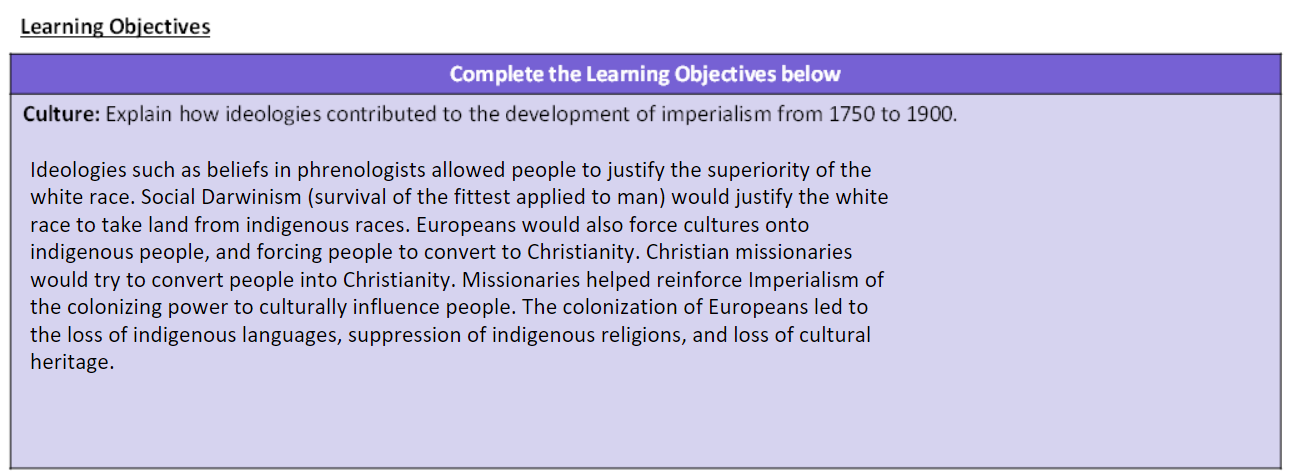6.1 Rationales for Imperialism
Belief in nationalism, desire for wealth, sense of religious duty, and belief they were biologically superior.
Nationalist Motives for Imperialism
Rise of nationalism and revolutions
Strong sense of identity and loyalty to a state
Establishing new colonies in places like Asia and Africa to assert its national identity in the global arena.
British
British have lost their American colonies so they established colonies in Australia, and Southeast Asia, India with the British East India Company.
By 1857 Britain controlled the entire Indian subcontinent
France
France will have to compensate for their defeat in wars they have been losing in Europe and will expand its overseas territories
Will expand into Asia, the South Pacific, and Africa.
Will want to compete with other states for more power and influence
Spain
Spain will have very few colonies, the Philippines.
There are no major Spanish colonies
Japanese
First countries in Asia to industrialized
They expanded into Korea and invaded it
This irritated China, which led to the Sino-Japanese War
Cultural and Religious Motives for Imperialism
Racism and race becoming one of the motives for imperialism
Pseudoscientists: People who present theories as a science that are incompatible with the scientific method. (No evidence that it is scientifically true)
Pseudoscientists will say they have proof of the intellectual and physical inferiority of nonwhite races.
Phrenologists: People who studied skull sizes and shapes, believed a smaller skull size proved mental feebleness of Africans, indigenous Americans, and Asians.
These ideas have been proven false.
Charles Darwin’s theory of survival of the fittest of species
Animals being able to adapt to their environment “adaptation”
Social Darwinism- Survival of the fittest but for humans
He did not believe his theory should apply to humans (justification to say biologically the white race is superior, which would justify taking land from “inferior” races. Also forcing cultures onto indigenous people, and forcing people to convert to Christianity.
Many colonies combined peoples from several cultures who often spoke different languages and had different customs into a single colony to make it easier to govern.
Colonizers introduced their language to help unify these often diverse colonies
They also introduced their political, educational, and religious institutions and exerted cultural influences on architecture and recreational activities.
Missionaries- their goal was to convert people to Christianity
Try to convince people to give up their own beliefs
Missionaries help reinforce the Imperialism of the colonizing powers to culturally influence people
Missionaries often set up schools. Taught secular AND Religion
They provided medical care and early-day hospitals
David Livingstone- worked in Sub-Saharan Africa to end the illegal slave trade
Economic Motives for Imperialism
To maximize profits, governments signed commercial treaties with local rulers allowing Europeans to establish trading posts and forts to protect their interests
These companies were formed primarily for the spice trade, but many companies had pseudo-governmental powers, raising armies and conquering territory to form colonies.
As the Industrial Revolution transformed European economies, the need for new sources of raw materials and markets for manufactured goods increased their expansion by imperial powers.
Imperial powers often competed with one another over the best potential resources, markets, trade, and demands for low-age labor access to markers, and control of natural resources increased.
1600: The English monarch granted the (British) East India Company a royal charter giving it a monopoly on England's trade with India.
British are going to take over India by kicking the Portuguese out.
The company traded primarily in cotton and silk, indigo, and spices.
Its colonies provided raw materials (cotton, wool, jute, vegetable oil, rubber) as well as food for its growing cities.
The second wave of the Industrial Revolution and more competition between Imperial powers
Dutch
From South Africa throughout the Atlantic/Indian Ocean, the British had a monopoly of trade
Corruption and debt led the government to take control of the company's possessions, creating the Dutch East Indies (today's Indonesia).
Culture: Learning Objective

Mind Map: Political, Social, and Cultural Impacts of Imperialism (1750-1900)
Central Idea: Imperialism (1750-1900)
Main Branches:
Political Impacts
Social Impacts
Cultural Impacts
Political Impacts
Sub-branches:
Colonization and Annexation
Establishment of European colonies
Annexation of territories
Political Control
Imposition of European political systems
Suppression of local governance
Economic Exploitation
Extraction of resources
Imposition of trade policies
Resistance Movements
Nationalist uprisings
Anti-colonial movements
Social Impacts
Sub-branches:
Demographic Changes
Migration of Europeans
Population decline in indigenous communities
Social Hierarchy
Racial segregation
Discrimination and inequality
Westernization
Adoption of European customs and values
Cultural assimilation
Education and Healthcare
Introduction of Western Education Systems
Healthcare improvements and challenges
Cultural Impacts
Sub-branches:
Language and Communication
Spread of European languages
Loss of indigenous languages
Religion and Beliefs
Conversion to Christianity
Suppression of indigenous religions
Art, Literature, and Media
Western influence on artistic expressions
Preservation and loss of cultural heritage
Identity and Nationalism
Formation of national identities
Cultural resistance and revival movements
Note: This mind map provides a brief overview of the political, social, and cultural impacts of imperialism from 1750 to 1900. Further exploration of each sub-branch will reveal more specific details and examples.